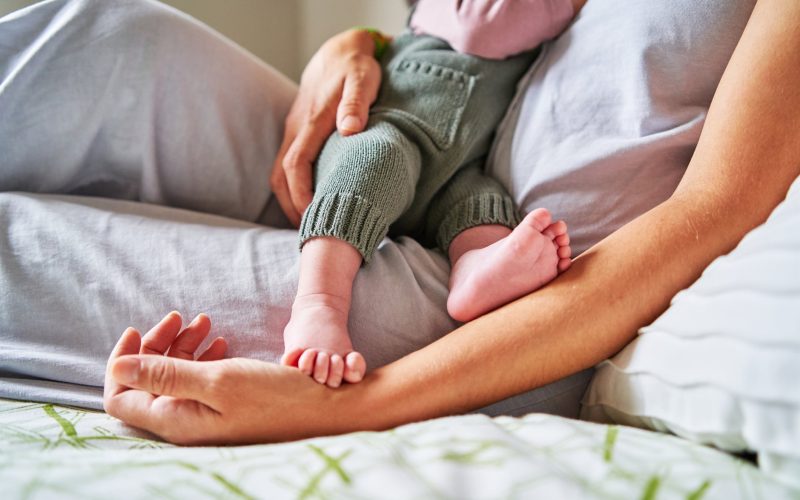Ohioan Clare Barkley has long dreamed of having a second child. She claimed that the world feels unstable and that she is unsure if she wants to take a chance after witnessing the decline of reproductive rights and the battles for public health and education.
Kristen Witkowski, a mother of two from North Carolina, has experienced multiple potentially fatal pregnancy problems. Although she might have thought about having a third kid, she stated she wishes she had had her fallopian tubes blocked during her second Cesarean section since she is now so afraid of being pregnant again.
And in Arizona, Brenna Craven Dumas, a mother of two who had high-risk pregnancies, had her tubes sealed and asked her husband to have a vasectomy because she wanted to be absolutely certain she wouldn’t get pregnant again.
These women stated that their fertility decisions were influenced by or primarily motivated by states that have banned abortion, either currently or in the past.
According to the Centers for Disease Control and Prevention, the United States’ national fertility rate—which is defined as the total number of live births per 1,000 women of reproductive age—has been gradually declining over the last ten years, from 62.5 in 2013 to 54.5 in 2023. According to the data, the decline is evident to varied degrees in every state. States that forbid abortion have seen dramatic declines in rates during the same period, such as Arizona, where the rate went from 66.3 to 54.1, and Idaho, where it plummeted from 71.8 to 57.5.
For elected lawmakers connected to President Donald Trump’s second term in office, such fertility declines have been a major concern. It is a key component of Project 2025, the Republican Heritage Foundation’s and a number of anti-abortion groups’ strategy for Trump’s presidency.
New U.S. Department of Transportation Secretary Sean Duffy issued an amemo on January 29 directing programs funded or supported by transportation money to prioritize localities with greater marriage and birth rates than the national average. Duffy backed and co-sponsored numerous anti-abortion proposals while serving as a congressman representing Wisconsin, including one that would have cut off funding to Planned Parenthood.
For a number of years, Vice President JD Vance has voiced concerns about the declining fertility rates. During the 2024 presidential election, he was frequently criticized for his disparaging remarks about childless women and society’s growing disengagement from the ideal of parenthood. He has maintained that laws restricting or outlawing access to abortion, which he supports, are not causing the rates to rise. He also favors raising taxes on non-parents and increasing the child tax credit to assist families.
“At the annual anti-abortion March for Life event in January, Vance stated that our society has failed to recognize that the obligation that one generation has to another is a core part of living in a society to begin with.” I want more babies in the United States of America, to put it simply.
Why fertility rates are lower
According to Phillip Cohen, a professor of sociology with a focus on population science at the University of Maryland, birth rates have been falling for millennia as society has moved away from utilizing children as labor.
That reduces the number of children per woman from eight to three or four. The question then becomes, what causes you to continue to drop to such extremely low numbers? Cohen stated.
He blames both positive and negative elements for the deterioration during the last 20 years. Along with more career and personal goals that were previously more challenging or impossible to accomplish, people—especially women—have more choices to spend their time in other ways. Despite the fact that some women manage a family and a job, there is frequently pressure to select one for personal, societal, or financial reasons.
According to Cohen, the costs associated with having children, risk, and uncertainty are the negative reasons causing rates to decline.
According to Cohen, there is worry about how to raise kids who can thrive in a culture where failure seems to have a heavier price and who are competitive in an increasingly unfair environment. You can improve your odds of your children prospering by having fewer of them if you’re concerned about their future, as many Americans are.
For Katie T. in Alabama, that is accurate. As one of four children growing up in Alabama, she always imagined having a large family—likely five children.
But after five months of being a first-time mother, the economy, and recent political events like Trump’s reelection, she has concluded that one child is enough.
Following the birth of their kid in August, she and her spouse are one and done. As a pregnant woman nearing 35, the age at which pregnancies are deemed greater risk by medical professionals, Katie said she was already anxious about living in a state that forbids abortions almost completely in case something went wrong. Virginia, the closest state with widespread access to abortion, is around ten hours away by automobile.
“I went in for my first checkup after having my baby to discuss birth control options, and I had a lengthy conversation with my husband about how I just don’t think (more kids are) in our future anymore,” she said.
Additionally, money was a major concern.
According to her, we are now learning that childcare is essentially a second mortgage payment, which we just cannot afford.
She expressed her disappointment at not having a sibling for her son. Having more than one child was significant to her for a long time because her siblings are all older than her and she talks about growing up practically as an alone child. However, Katie said she had an eight-year birth control implant put shortly after the election since she had to deal with the realities of political battles over vaccines and the educational system as well as more possible limitations on reproductive health care.
“I hope that one day he will pardon us for that,” she stated.
If something happens, where do we go from there?
Kiley DeVor, 28, is a pelvic floor therapy specialist who relocated from California to Idaho to pursue a degree in physical therapy. Before the U.S. Supreme Court’s Dobbs ruling in June 2022 and Idaho’s near-total abortion ban went into effect, she and her husband purchased a home in the hopes of remaining in Idaho for some time. In the last two years, the state has been at the focus of a number of abortion-related litigation, including one that was heard by the Supreme Court in June regarding whether abortions carried out in the course of a medical emergency are punishable by state law. The U.S. Court of Appeals’ 9th Circuit is presently considering that case.
DeVor claimed that over that period, she has learned of additional health conditions that could make getting pregnant more difficult, in addition to the endometriosis she has had for many years.
It’s going to be really hard for us to conceive, so that’s one obstacle, and if something does happen, what are we going to do next? “I said,” she said. It’s simply not practical if we have to use IVF or IUI and I have to travel out of state and pay an additional $10,000 or $20,000 to receive the services I require.
DeVor’s husband established a successful general contracting firm in Idaho, but she stated that he would rather to wait until they could relocate somewhere where she is confident her health care will be covered rather than take the chance of establishing a family there.
Moving to a state where people say, “We don’t want big government,” while still telling them, “This is what you can and can’t do,” has been an intriguing experience, DeVor said.
Idaho economist doesn t see worrying trends so far in population movement
It’s unclear how many of those departures are linked to politics, even though a recent research from the National Bureau of Economic Research found that the 13 states with complete abortion prohibitions are losing 36,000 citizens every quarter on average, according to change of address data from the USPS. In 2023, around 82,000 people relocated to Idaho and nearly 65,000 moved out, resulting in a net increase of roughly 16,700 residents, according to statistics from the American Community Survey.
According to Jan Roeser, a regional economist with the Idaho Department of Labor, the state’s population growth has slowed over the last two years after accelerating significantly between 2020 and 2022 during the COVID pandemic.
With seven districts announcing or considering school closures in the first half of 2023 due to decreased enrollment, Roeser said it’s probable that more young people are leaving the state. This information was reported by Idaho Education News. However, she noted that Idaho is one of the top states for job development and one of the eight youngest in the country.
We d all like to be able to jump up and move just based on our beliefs, but the reality hits that most of us need a job, Roeser said. So really, economic opportunity is what I believe allows people to be able to make that final decision, because it s expensive, and it s disorienting.
Until she starts seeing indicators like a spike in layoffs or a decline in enrollment at state universities, Roeser isn t too concerned about outmigration. But she does worry about the steady decline of fertility rates.
There s not much you can do about it, of course, and it takes a long time to reverse once it starts, she said. It s not something you can solve by coming up with public policy.
Cohen said abortion bans may lead to a small increase in births initially since access is harder to reach, but in the long run, he expects it to contribute more to decreases because it creates uncertainty and fear about pregnancy.
Economically, increasing fertility rates would be a financial drain and potentially hamper growth, he said. That doesn t mean policies that make it easier to have more children aren t worth having, but they shouldn t be done in the interest of increasing births.
It s one of the great victories of human development that we allowed people to lower their birth rates, he said.
I m not going to let them get me down
For some people, having more children is almost an act of resistance.
Rachel West, a 34-year-old resident of central Texas, had a baby five months ago after a three-year struggle to conceive. She wants at least one more, but knows it might be a stressful experience again because of where she lives. Texas has a near-total abortion ban, along with an attorney general who hasattempted to prosecutewomen who left the state to have an abortion. Cities in Texas have alsotried to institute travel bansto prevent women from crossing state lines for abortions.
At the beginning of her pregnancy, West said there were concerns that her embryo was ectopic, when a baby grows in the fallopian tube rather than the uterus. Ectopic pregnancies are not viable and require termination to prevent infection and loss of fertility.
We did have to think through what that would look like, if we would have to terminate, if we would have trouble finding somebody, she said. It was scary, we were just kind of spiraling at home trying to figure out what we would do.
As someone who struggled to get pregnant the first time, West has also been concerned about efforts to restrict or ban IVF, just in case it becomes an option she has to utilize. But all of the news developments haven t deterred her from the idea of having another.
We ve always wanted to have at least two, maybe three kids, and I would be very frustrated if because of laws in Texas, I had to change my personal life that dramatically, West said. It s almost a prideful thing, where I m like, I m not going to let them get me down.
Kelcie Moseley-Morris,States Newsroom








